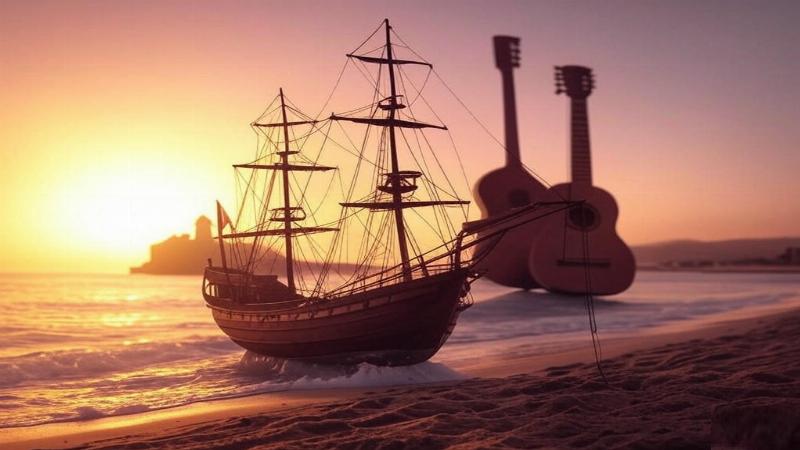Place for ads

Cape Verde, a cluster of ten volcanic islands off West Africa’s coast, is a nation where azure seas meet a storied past. Covering 4,033 square kilometers in the Atlantic Ocean, it lies 570 kilometers west of Senegal, its arid landscapes softened by resilient spirit. Known today for its morna music, Creole culture, and tourism, Cape Verde’s history blends uninhabited origins, colonial exploitation, and modern independence. In this article, we’ll trace Cape Verde’s past, from its earliest days to its contemporary identity, uncovering the milestones that have shaped this remarkable archipelago.
Unlike most nations, Cape Verde’s human history starts late—its islands were uninhabited until the 15th century. Geological evidence dates their volcanic birth to millions of years ago—Santo Antão’s rugged peaks and Fogo’s active crater tell of fiery origins. Fossils of extinct birds, like the Cape Verde giant skink, hint at prehistoric life, but no human trace exists before European arrival.
The islands’ isolation—cut off by ocean currents—kept them empty. Sparse vegetation—acacias and dragon trees—fed goats left by passing sailors, but no Indigenous peoples settled. This blank slate made Cape Verde a unique canvas for its discoverers, shaped entirely by external hands.
Place for ads
In 1456, Portuguese explorers—sent by Prince Henry the Navigator—stumbled upon Cape Verde. Captains António de Noli and Diogo Gomes claimed the islands, naming them “Cabo Verde” (Green Cape) despite their dryness, perhaps for Senegal’s nearby coast. Portugal saw potential—Santiago, the largest isle, hosted Ribeira Grande (now Cidade Velha) as the first settlement by 1462.
Uninhabited, Cape Verde became a colonial experiment—settlers from Portugal mixed with enslaved Africans from Guinea and Senegal, birthing a Creole population. By 1495, Ribeira Grande was a diocese, its cathedral Africa’s first European-built church. The islands’ strategic spot fueled trade—salt from Sal and Maio drew merchants.
The 16th century turned Cape Verde into a slave trade hub—over 100,000 Africans passed through Ribeira Grande’s docks, bound for Brazil and the Caribbean. Enslaved labor grew sugar and cotton—Santiago’s plantations thrived briefly, though drought and soil exhaustion soon curbed output. Portuguese neglect followed—pirates like Francis Drake sacked the town in 1585.
Creole society emerged—mixed-race “lançados” traded inland, blending African and European ways. The 18th century saw decline—famines killed thousands, and trade shifted to mainland ports. Praia replaced Ribeira Grande as capital in 1770, its harbor safer, but Cape Verde remained a colonial backwater, its people resilient amid hardship.
The 1807 British slave trade ban hit Cape Verde hard—its economy faltered, though whaling and fishing rose. American ships hired Creole sailors—many settled in New Bedford, Massachusetts, starting a diaspora. Droughts—killing 40% of the population in the 1860s—pushed emigration; islands like Brava became ghost towns.
Portugal clung to control—Cape Verdeans gained minor roles, but Lisbon ruled. The 1878 elevation to “overseas province” offered little—education lagged, though Creole elites like poet Eugénio Tavares penned resistance in Kriolu. The islands’ isolation bred a distinct identity, ripe for change.
Post-World War II, African nationalism stirred—Amílcar Cabral, born in Guinea-Bissau to Cape Verdean parents, led the PAIGC (African Party for the Independence of Guinea and Cape Verde) from 1956. His vision tied the islands to mainland struggle—guerrillas trained in Cuba, striking Portuguese forts. Cabral’s 1973 assassination didn’t halt the fight.
Portugal’s 1974 Carnation Revolution toppled its dictatorship—Cape Verde gained independence on July 5, 1975, under Aristides Pereira. Linked to Guinea-Bissau in spirit, it chose a separate path—Praia became the seat of a socialist state, though droughts and aid dependency tested early years.
The 1991 shift to multiparty democracy—António Mascarenhas Monteiro’s victory—marked stability. The MPCR won, ending PAICV rule—free markets opened, and tourism bloomed on Sal’s beaches. Cesária Évora’s morna songs globalized Cape Verdean soul—her barefoot grace won Grammys by 2004.
Today, Cape Verde’s 600,000 people thrive—remittances from 700,000 abroad fuel growth. Fish, salt, and wind energy drive the economy—90% literacy and healthcare shine in Africa. Climate change—rising seas, less rain—looms, but culture—sodade, funaná dances—endures, a beacon of hope.
Cape Verde’s history is an Atlantic odyssey—from empty isles to Creole heart, colonial chains to modern wings. Its waves sing of survival, its people pulse with pride. As Cape Verde strides forward, its past fuels a legacy of unity and song.
Place for ads